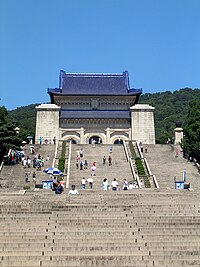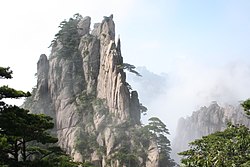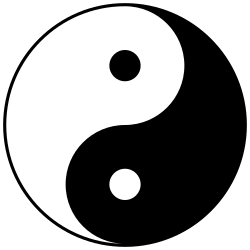Portal:China
熱烈歡迎 – Herzlich willkommen im Portal China |  |  |  |  |
China gehört zu den ältesten Zivilisationen und Hochkulturen der Menschheit. Im Laufe seiner langen Geschichte hatten Chinas Kunst, Philosophie und Religion sehr großen Einfluss auf die ostasiatische Welt. Die Volksrepublik China ist der flächengrößte Staat in Ostasien und mit mehr als 1,3 Milliarden Einwohnern das bevölkerungsreichste Land der Erde. Auf der Insel Taiwan existiert außerdem die Republik China, die im Zuge des Taiwan-Konflikts um ihre Selbstständigkeit kämpft. Das Portal China wurde geschaffen, um dem interessierten Leser einen schnellen Einstieg in das Reich der Mitte mit seiner vielfältigen Kultur zu bieten. Zum Themenbereich China gibt es derzeit 30.424 Artikel. | ||||
Qualitätsprädikat:
Auf dieser Seite verwendete Medien
Pictured here is former Chinese Communist Party chairman Mao Zedong announcing the founding of the People's Republic of China on October 1 1949.
Autor/Urheber: Anthony Hartman aus Meizhou, China, Lizenz: CC BY 2.0
On Chinese New Year's Eve in Meizhou. Fireworks are set off to ward off the bad spirits from the previous year and welcome the new year in. Candles and incense are also lighted during prayers, like this scene on Chinese New Year's Eve.
New Year Scene
Autor/Urheber: user:snowyowls, Lizenz: CC BY-SA 2.0
The Classic of Rites (礼记) was one of the Five Classics of Confucianism; it described social forms, ancient rites, and court ceremonies. Taken in Beijing zoo,Beijing,China.
Portrait of the general Jiang Wei from a Qing Dynasty edition of The Romance of the Three Kingdoms.
Autor/Urheber: Jakub Hałun, Lizenz: CC BY-SA 4.0
Great Wall of China near Jinshanling
Autor/Urheber: J. Patrick Fischer, Lizenz: CC BY-SA 3.0
Tagesansicht von Pudong vom Bund aus.
Autor/Urheber: Saad Akhtar from New Delhi, India, Lizenz: CC BY 2.0
The Hall of Prayer for Good Harvest, Temple of Heaven, Beijing
Autor/Urheber: Jiong Sheng from London, United Kingdom, Lizenz: CC BY-SA 2.0
The main hall of Sun Yat-sen Mausoleum
This is the Taijitu (太極圖), with black representing yin and white representing yang. It is a symbol that reflects the inescapably intertwined duality of all things in nature, a common theme in Taoism. No quality is independent of its opposite, nor so pure that it does not contain its opposite in a diminished form: these concepts are depicted by the vague division between black and white, the flowing boundary between the two, and the smaller circles within the large regions.
Autor/Urheber: ryanne lai, Lizenz: CC BY 2.0
20th anniversary of the June 4th incident.



























